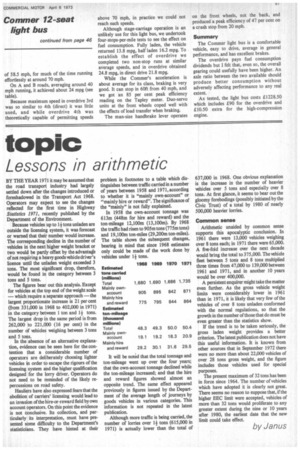topic
Page 53

If you've noticed an error in this article please click here to report it so we can fix it.
Lessons in arithmetic
BY THE YEAR 1971 it may be assumed that the road transport industry had largely settled down after the changes introduced or foreshadowed in the Transport Act 1968. Operators may expect to see the changes reflected for the first time in Highway Statistics 1971, recently published by the Department of the Environment.
Because vehicles up to tons unladen are outside the licensing system, it was forecast or warned that their number would increase. The corresponding decline in the number of vehicles in the next higher weight bracket or two would be partly offset by the advantage of not requiring a heavy goods vehicle driver's licence until the unladen weight exceeded 3 tons. The most significant drop, therefore, would be found in the category between 3 tons and 5 tons.
The figures bear, out this analysis. Except for vehicles at the tiop end of the weight scale — which require a separate approach —the largest proportionate increase is 21 per cent (from 331,000 in 1968 to 402,000 in 1971) in the category between 1 ton and 1+ tons. The largest drop in the same period is from 262,000 to 221,000 (16 per cent) in the number of vehicles weighing between 3 tons and 5 tons.
In the absence of an alternative explanation, evidence can be seen here for the contention that a considerable number of operators are deliberately choosing lighter vehicles in order to escape the rigours of the licensing system and the higher qualification designed for the lorry driver. Operators do not need to be reminded of the likely repercussions on road safety.
Hauliers have also expressed fears that the abolition of carriers' licensing would lead to an invasion of the hi re-or-reward field by own account operators. On this point the evidence is not conclusive. Its collection, and particularly its interpretation, must have presented some difficulty to the Department's statisticians. They have hinted at their problem in footnotes to a table which distinguishes between traffic carried in a number of years between 1958 and 1971, according to whether it is "mainly own-account" or "mainly hire or reward". The significance of the "mainly" is not fully explained.
In 1958 the own-account tonnage was 613m (448m for hire and reward) and the ton-mileage 12,100m (13,100m). By 1968 the traffic had risen to 905m tons (775m tons) and 19,100m ton-miles (29,200m ton-miles). The table shows the subsequent changes, bearing in mind that since 1968 estimates only could be made of the work done by vehicles under 11 tons.
It will be noted that the total tonnage and ton-mileage went up over the four years; that the own-account tonnage declined while the ton-mileage increased; and that the hire and reward figures showed almost an opposite trend. The same effect appeared previously in figures issued by the Department of the average length of journeys by goods vehicles in various categories. This information is not repeated in the latest publication.
Although more traffic is being carried, the number of lorries over 1+ tons (615,000 in 1971) is actually lower than the total of 637,000 in 1968. One obvious explanation is the increase in the number of heavier vehicles over 5 tons and especially over 8 tons. At first glance, it seems to bear out the gloomy forebodings (possibly initiated by the Civic Trust) of a total by 1980 of nearly 500,000 heavier lorries.
Common sense
Arithmetic unaided by common sense supports this apocalyptic conclusion. In 1961 there were 13,000 vehicles weighing over 8 tons each; in 1971 there were 65,000. A five-fold increase over the next decade would bring the total to 375,000. The vehicle 1971 fleet between 5 tons and 8 tons multiplied three times from 47,000 to 139,000 between 1961 and 1971, and in another 10 years would be over 400,000.
A persistent enquirer might take the matter even further. As the gross vehicle weight limits were considerably lower in 1961 than in 1971, it is likely that very few of the vehicles of over 8 tons unladen conformed with the normal regulations, so that the growth in the number of those that do must be even greater than the statistics show.
If the trend is to be taken seriously, the gross laden weight provides a better criterion. The latest publication does not have this useful information. It is known from other sources that in September 1972 there were no more than about 22,000 vehicles of over 28 tons gross weight, and the figure includes those vehicles used for special purposes.
The present maximum of 32 tons has been in force since 1964. The number of vehicles which have adopted it is clearly not great. There seems no reason to suppose that, if the higher EEC limit were accepted, vehicles of more than 32 tons would proliferate to any greater extent during the nine or 10 years after 1980, the earliest date that the new limit could take effect.
by Janus












































































































